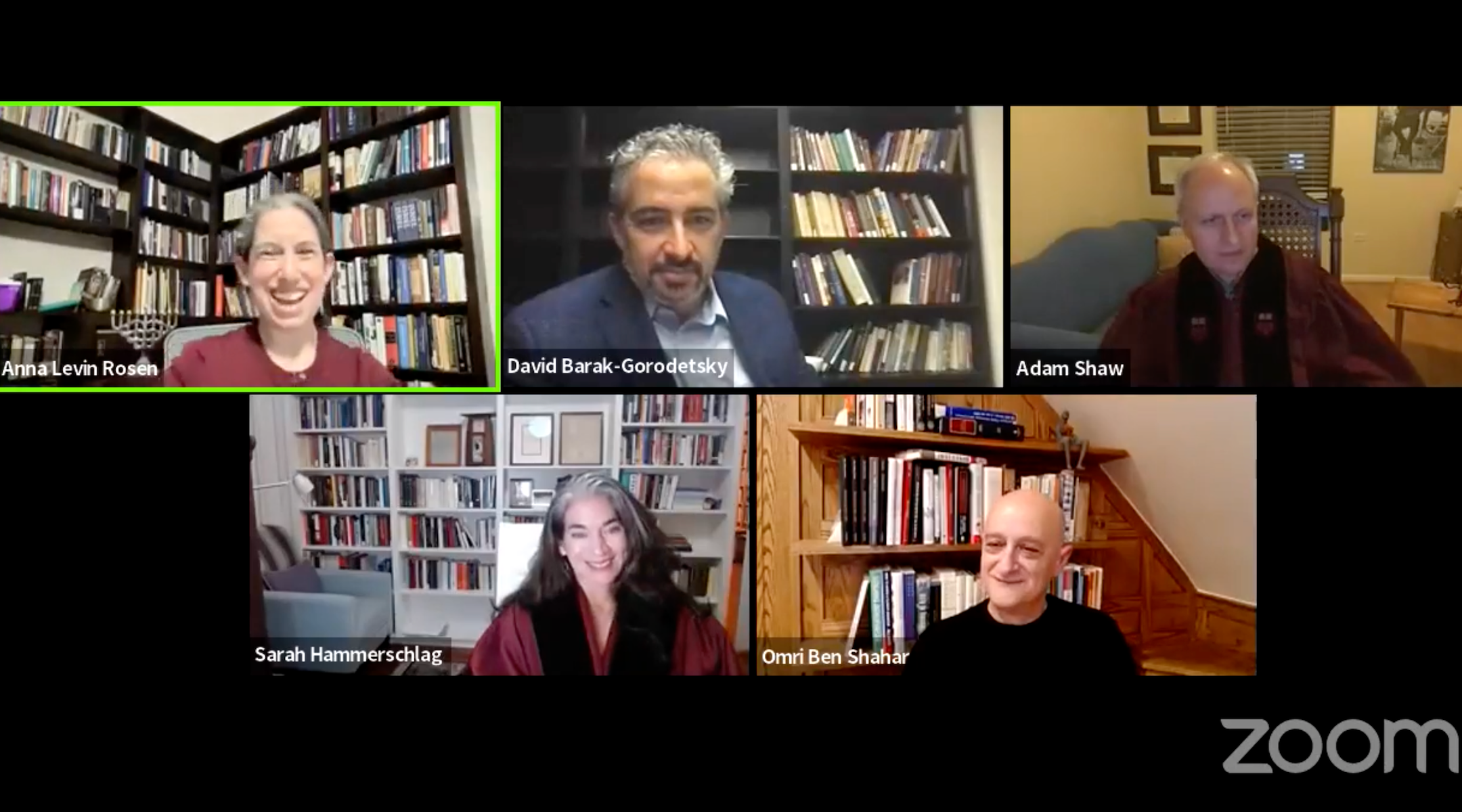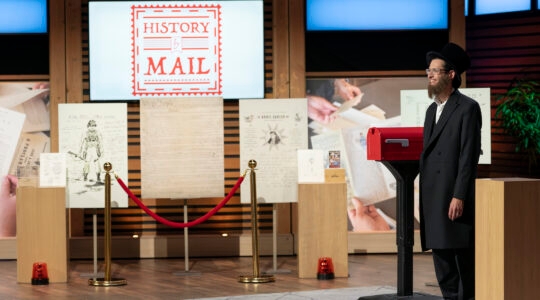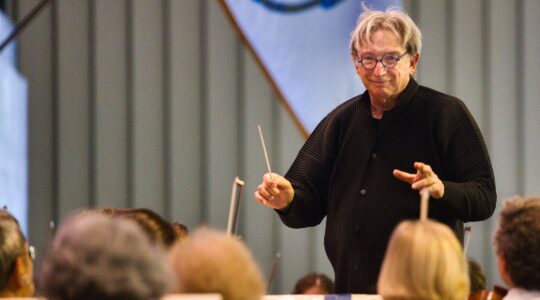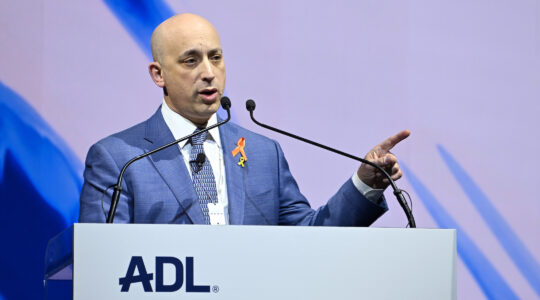(JTA) — Since its founding in 1890, the University of Chicago has been a hub of scholarship and rigorous debate on numerous contentious subjects, from economics to law to science. But since 1946, the school has also hosted a debate on another long-running disagreement: whether latkes or hamantaschen are the superior Jewish holiday food.
Participants in the debate, hosted by the university’s Hillel chapter, have over the years included noted intellectuals, professors and government officials such as Allan Bloom, Milton Friedman and Austan Goolsbee. But over the three quarters of a century, there have been two constants — it has always been firmly tongue-in-cheek, and there has never been a definitive winner.
The 75th edition of the Latke-Hamantash Debate, which took place on Facebook Live and Zoom on Thursday night, was billed as a “retrospective.” Rabbi Anna Levin Rosen, executive director and rabbi at the school’s Newberger Hillel Center, began the event by going through the history of the debate and naming a “winner” from each past decade, arguing that the two foods had alternated victories over the course of the debate’s seven decades to date.
In the 1970s, for instance, infamous gas shortages made “oil” more important, thus delivering a win to the latke. But in the ’80s, the uniquely shaped shoulders of women’s fashion granted the victory to hamentashen.
The event, which lasted a little over an hour and drew nearly 2,000 viewers to the Facebook stream, went beyond the retrospective, however. As usual, the discussions formed less of a “debate” than a series of presentations. The participants employed a dry, academic style of humor, citing fake sources and imaginary evidence from biblical and academic sources, as well as multiple nods to The New York Times.
Arguing for the latke was Sarah Hammerschlag, a professor of religion and literature, philosophy of religions and history of Judaism in the university’s Divinity School; and arguing for the hamantash was Omri Ben-Shahar, the Leo and Eileen Herzel Professor of Law. Adam Shaw, a professor in the department of computer science, took part as a “swing debater.”
Citing the much-referenced recent New York Times magazine article about “Inside the Unraveling of American Zionism,” Hammerschlag zeroed in on a line in the piece asking whether “the median American Jew — Ashkenazic, native-born, lightly religious — [has] become a white person who knows a potato pancake is called a latke.”
Hammerschlag went on to argue that “the latke is not here the cause, but the solution” — it might even have a messianic role to play, she argued, humorously inserting a latke into the Talmudic story of the “The Messiah at the Gates of Rome.” Referencing the “ubiquity of the latke,” she argued that latkes could very well play a role in solving many of the seemingly intractable problems facing the Jewish people today.
Omri Ben-Shahar, in arguing the pro-hamantash side, also made a plea for unity, calling the food “our social glue.”
He detailed a completely imaginary controversy in which the latke had gained such a level of popularity that it was being served at McDonalds. He even included a bogus quote from the university’s former Hyde Park neighbor, Michelle Obama, that the latke would “help solve the problem of childhood obesity.” He then imagined a subsequent backlash and downfall for the cookie, which is eaten on Purim, not Hanukkah.
This was meant as a parody of a very real controversy. In 2015, the food magazine Bon Appetit published an online article called “How to Make Actually Good Hamantaschen,” and later apologized and re-edited it. This was shoehorned into a 2021 argument about cancel culture.
“The hamantash isn’t divisive at all — nothing unites Jews like complaining about hamantashan,” Ben-Shahar said.
“It nourishes our collective identity for spirited disagreement,” he added, as well as of participating in one of our greatest traditions: “Kvetching about food.”
Adam Shaw didn’t particularly take a side, but he did consider the question from what he called “a computational perspective.” He cited an “academic paper” authored by “C. Boy-ar-dee, et. al,” which was titled “Toward a Theory of Noshing,” and coined the phrase “Noshalogical Hyperspace.” And in honor of the recent passing of Jewish musical theater giant Stephen Sondheim, he shared a latke-themed original song called “Living a Sour Cream Dream.”
The final speaker was David Barack-Gorodetsky, who opined on “The Future of the Latke-Hamantashan Debate.” He noted that in Israel, the winner is neither, but rather the sufganiyah. He also speculated that in the future, we might see hamantash sushi, or perhaps hamantash AI.
While, once again, they did not resolve the debate, the debaters continued a long and proud tradition. In fact, a book-length recounting of the history of the University of Chicago debate up to that point, “The Great Latke-Hamantash Debate,” was published in 2005 by the University of Chicago Press.
“When scholarly life discouraged an open display of Jewish ethnicity, the event provided a rare opportunity for faculty to reveal their hidden Jewish souls and poke fun at the high seriousness of everyday academic life,” Ruth Fredman Cernea, editor of that book, said of the original debate in 1946, in the University of Chicago’s magazine at the time of the book’s publication.
The idea of a Latke-Hamentash Debate, while originated at the University of Chicago, has expanded much further over the years, including to such universities as Harvard and Brandeis. At the latter university, in 2007, noted Jewish studies scholar Professor Jonathan Sarna argued for the hamantash on five counts: “numerical value, history, language, semiotics, and public policy,” The Brandeis Hoot reported at the time.
Rabbi Joe Black, now the rabbi at Temple Emanuel in Denver and a noted musician, included a song called “Latke Hamentaschen Debate” on his 1992 album “Everybody’s Got a Little Music.” Rabbi Black, a Chicago native, told the Jewish Telegraphic Agency that he remembered hearing about the debate in his childhood.
When he was at Temple Israel in Minneapolis in the early 1990s, Black hosted a similar debate between Mark Rosen and Sid Hartman, a pair of Jewish, longtime sports media figures in the Twin Cities. And he’s continued the tradition at his current pulpit in Colorado.
“A couple of years ago [in March 2019], when we elected Jared Polis as our Governor and Phil Weiser as our attorney general (both Jewish) we held a latke hamantaschen debate between them with State Representative, Daphna Michaelson Jenet (also Jewish) as moderator,” Black said, adding that Rep. Jenet performed her duties while dressed as Justice Ruth Bader Ginsburg.
Rabbi Black says that he personally favors latkes — “I’m a savory character” — but agrees with most that the debate isn’t one that can be resolved.
JTA has documented Jewish history in real-time for over a century. Keep our journalism strong by joining us in supporting independent, award-winning reporting.






